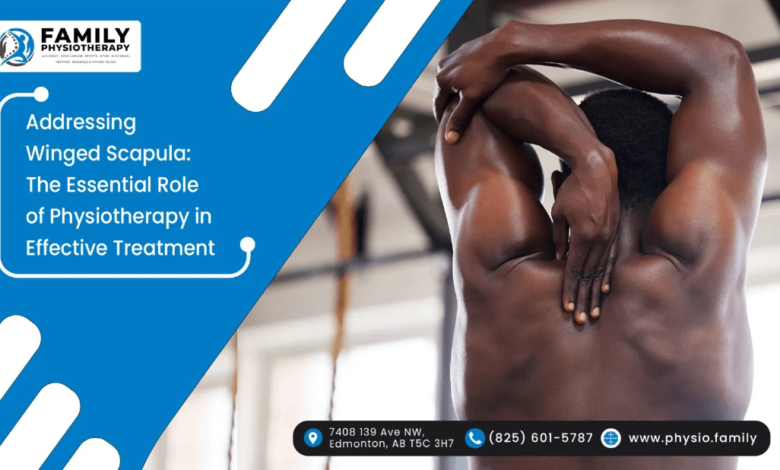Addressing Winged Scapula: The Essential Role of Physiotherapy in Effective Treatment

Physiotherapy offers effective treatments for managing conditions like winged scapula, where the scapula protrudes in a wing-like fashion due to nerve impairment or muscle issues. This therapeutic approach employs specialized exercises and modalities to strengthen affected areas, enhance joint functionality, and alleviate discomfort. By focusing on improving posture and muscle balance, physiotherapy Edmonton helps individuals regain essential movement capabilities, thus reducing the impact of this condition on everyday life and work-related tasks.
What is a Winged Scapula?
Winged scapula features a pronounced protrusion of the scapula, resembling a wing, usually due to thoracic nerve damage or muscle dysfunction. Causes include shoulder trauma, repetitive athletic injuries, or surgical complications. Those affected may struggle with basic activities like pushing or lifting, significantly reducing physical independence and occupational performance. This limitation can decrease life satisfaction by complicating simple tasks. Over time, reduced shoulder use may cause muscle atrophy and heightened discomfort, further worsening the condition.
The Role of Physiotherapy in Treating a Winged Scapula
Physiotherapy in Edmonton plays a crucial role in the treatment of a winged scapula. By focusing on muscle strengthening, postural correction, and targeted exercises, physiotherapy clinics offer an effective, non-invasive solution to help individuals regain full shoulder function.
1. Muscle Strengthening
Physiotherapy emphasizes strengthening the muscles responsible for scapular stability, particularly the serratus anterior, trapezius, and rhomboids. Strengthening exercises can help restore the scapula’s normal position against the rib cage. For example, exercises like wall push-ups, scapular retractions, and modified planks can activate and strengthen these muscles.
- Prone Y:
Lying face down on a flat surface, the patient extends their arms overhead in a ‘Y’ position, thumbs pointing upwards. This position targets the lower trapezius muscles. Lifting the arms off the ground and holding them for a few seconds before lowering them back down can help strengthen the muscles supporting the scapula, reducing the winging.
2. Postural Correction
Poor posture can exacerbate scapular winging. Physiotherapy incorporates postural training to help individuals maintain a neutral spine and proper shoulder alignment during daily activities. This helps reduce the strain on the shoulder muscles and prevents further complications.
- Pilates for Core and Postural Stability:
Pilates can be particularly beneficial for improving core strength and postural alignment, which are critical in managing winged scapula. Exercises that focus on core stabilization, like the plank or bridges, are integrated into routines to help maintain a neutral spine and pelvis, thus supporting correct shoulder alignment.
- Ergonomic Adjustments:
Alongside exercises, physiotherapists often assess the patient’s daily activity environment for ergonomic improvements. Adjusting the height of desks, chairs, and computer monitors can significantly reduce strain on the neck and shoulders, thereby improving posture and helping to correct winged scapula issues.
3. Neuromuscular Re-education
When nerve damage is involved, physiotherapy may focus on neuromuscular re-education, which aims to retrain the muscles and nerves to work together more efficiently. Techniques such as electrical stimulation may be used to help activate weak muscles and restore proper movement patterns.
- Proprioceptive Neuromuscular Facilitation (PNF):
PNF techniques involve specific stretching and contracting of the muscle groups around the scapula to enhance neuromuscular control and increase the range of motion. This method is often used to retrain the coordination between the serratus anterior, trapezius, and rhomboid muscles, which are essential for stabilizing the scapula.
4. Manual Therapy
Manual therapy techniques like soft tissue massage, mobilizations, and adjustments can be applied to alleviate discomfort, reduce muscle tension, and enhance joint mobility. These techniques help to correct biomechanical imbalances that might be contributing to the winged scapula.
- Myofascial Release:
This technique entails applying gentle, sustained pressure into the myofascial connective tissue restrictions to eliminate discomfort and restore motion. For winged scapula, myofascial release is often performed around the shoulder girdle and upper back to improve soft tissue mobility and enhance scapular movement.
- Joint Mobilizations:
Joint mobilizations involve passive movement of a joint to reduce stiffness and improve function. In cases of winged scapula, mobilizations may be applied to the shoulder joint, thoracic spine, and ribcage to enhance joint mobility and encourage correct movement patterns of the scapula.
- Scapular Mobilizations:
Specifically targeting the scapula, these mobilizations help correct its position and movement. Techniques may involve manual adjustments to the scapula itself, gently guiding it towards a more normal position relative to the rib cage, thereby addressing the winging directly.
5. Pain Management
Addressing pain is an important aspect of physiotherapy for winged scapula. Various modalities, such as heat therapy, ultrasound, or cold therapy, may be used to reduce inflammation and alleviate discomfort, making it easier to perform strengthening exercises.
- Ultrasound Therapy:
Ultrasound therapy targets the tissues around the scapula with sound waves, promoting healing and reducing pain by increasing blood flow and decreasing muscle stiffness.
- Shockwave Therapy:
Shockwave therapy utilizes high-energy sound waves to stimulate natural healing processes, effectively reducing inflammation and alleviating chronic pain associated with winged scapula.
- TENS:
TENS provides pain relief by using electrical currents to interrupt pain signals to the brain, particularly effective for sharp pains in the winged scapula.
Kinesiology Taping:
Kinesiology taping supports the scapula by lifting the skin, which decreases pressure on underlying tissues and improves circulation, helping to manage pain and enhance movement.
Read also: 3 Exercises to Improve Jaw Strength and Flexibility in TMJ Dysfunction
Your Path to Recovery from Winged Scapula:
In Edmonton, physiotherapy effectively manages winged scapula through tailored pain management techniques specific to each patient’s needs. By addressing the underlying causes of scapular winging, Family Physiotherapy significantly improves shoulder stability, reduces pain, and maximizes overall function and quality of life.
If you are noticing symptoms of winged scapula, seeking professional guidance from a qualified “physiotherapist near me” can be the first step toward achieving better health and regaining your independence in daily activities. Our physiotherapy in Edmonton ensures a personalized treatment plan that tackles your specific needs, helping you return to your usual activities with greater comfort and efficiency. Don’t let winged scapula hold you back—help is just around the corner at your local physiotherapy clinic.





